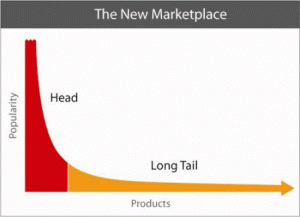I recently read Chris Anderson’s book The Long Tail. For those who have not read it, the long tail is a mathematics term that helps describe how a business can maximize their sales by catering to niches rather than focusing only on hits, or popular items. By selling smaller amounts of more items, you generate larger sales because you can meet more people’s needs. Doing business on the Internet makes this easy because it lets you lower inventory and distribution costs, allows 24/7 shopping, provides a very large inventory and enables differential pricing; all items Chris discusses in his book that are key for the long tail. Companies like Amazon and NetFlix embody this principal by offering millions of items online rather than the thousands available in their brick and mortar competitors. Since product information is just an entry in a database, customers can tag and sort items as they see fit and find exactly what they want. It’s easy to slice and dice an inventory into limitless categories and present that to customers in a way that makes sense to them. This helps make sense of the limitless quantity and fuels the sale of niche items.

So how does this affect SaaS? Delivering software over the Internet as a service uses the long tail principal. The inventory and distribution costs are virtually zero; there is of course a real cost of housing all the data for a customer, but they pay for that with their subscription. Most SaaS applications use the same code base and just turn on or off certain features to get different products. It can also be easy to add features that make the same product more attractive to vertical markets. Products like BatchBook, Basecamp and Freshbooks have numerous pricing models that accommodates many different customers. They even have free trials or basic free accounts to get me started. The sales and marketing costs are low because most of the sales are self service. This gets well down into the long tail by accommodating a very large customer base. So the cost of customer acquisition is low and the cost of providing the service is low.
Not all SaaS applications are sold as self service, but I believe the best ones are or should be. There are enterprise products that are very complex that seem to require a sales force and a long sales cycle. Many of these come from on-premise software vendors who then moved into SaaS. But look at Salesforce.com. They took a complex product type, made it simpler and enabled self-service. As products and companies drive the traditional costs of inventory, distribution and customer acquisition toward zero, they take great advantage of the long tail. A sale to a new customer who finds me on the Internet and signs up themselves can be very high margin. I think this is where the future lies.

